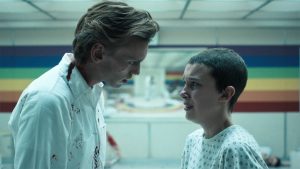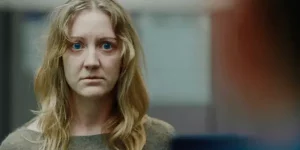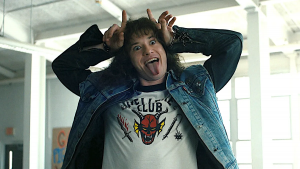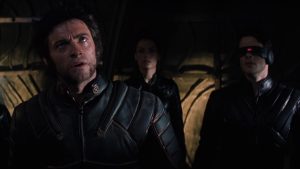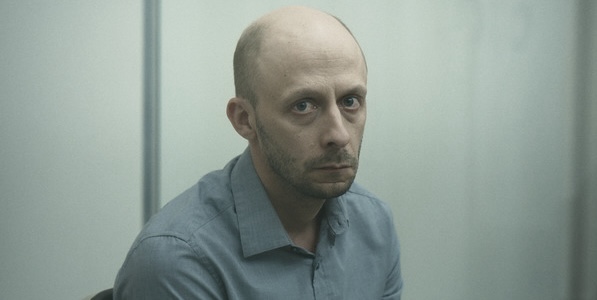
A small, washed out man sits in a glass box, staring down at his prison-issue shoes. A prosecutor describes a series of grisly murders, sexual torture and bloody slaughter filmed for a paying audience on the dark web, showing photos of the fresh-faced teenage girls who fell victim to the killer in question, whose eyes she claims will be identified as the man’s. The testimony is in-depth, calm, but extreme; the audience squirms. The defense stands up, raises his eyebrows, speaks for a while, concludes with a question: “Are you sure?” A young woman watches from the audience, a tear falling down her cheek, overcome with – something.
Pascal Plante’s Red Rooms is an exercise in epistemological uncertainty, as impersonal as the glazed surfaces of an ultra-modern courthouse, cold as stale air conditioning implacably blasted long after the chill of fall has set in. It’s about murder groupies, torture porn, loneliness, power. It’s hypnotic, eerie, enticing, and undeniably repulsive, a procedural with the stifling rhythms of an addiction story or a dream. Red Rooms’ unreliable narrator is Kelly-Anne (Juliette Gariépy) a statuesque model known for her “edgy” style who starts spending her days at the courthouse for the trial of Ludovic Chevalier (Maxwell McCabe-Lokos), befriending Clementine (Laurie Babin), a star-struck young woman who hitched in from out of town just to see him in person. One of the victim’s mothers (Elisabeth Locas) sits ahead of them daily, barely restraining her wrath at the women she describes as “a plague” on the survivor’s lives.
source: Nemesis Films
The film’s central questions are thorny, deceptively simple: Most obviously, did Ludovic commit the crimes with which he’s charged? Clementine’s anonymous groupie love for the accused hinges on his innocence, but Kelly-Anne’s motives are opaque. Is she an Underground Man in sheep’s clothing? What is her relationship to the case?
Draw near and fear not
A loner with a deep knowledge of the dark web, Kelly-Anne goes by “The Lady of Shalott” online, her personalized virtual assistant, Guinevere (King Arthur’s unfaithful bride, a ghostly symbol of female agency), her constant companion. The story of the Lady of Shalott – a classic tale of feminine sexual repression and alienation about a woman who lives her life locked in a tower creating a “web” of alternative worlds, stuck reflecting on life outside through her mirror – is in many ways the skeleton key to this film’s depiction of the cybernetic uncanny. As Tennyson tells it, the lady escapes her tower and dies, beautifying her own corpse for the people of Camelot, drifting down the river in a boat with a declaration of tragic, outsider independence attached.
source: Nemesis Films
Kelly-Anne, then, is a self-consciously undead figure, taking this tragic name as both apologia and warning, weaving her digital web in an ascetic highrise tower made of glass, a computer table the only piece of furniture visible in her apartment. Gariépy is mesmerizing as Kelly-Anne, playing her on a constantly shifting spectrum of controlled emotions, large, round eyes sharklike and watchful, working out her emotions in solo games of wall ball like a Quebequis Psycho or, possibly, a modern version of Simone in Der Fan.
Plante plays a slippery game with the question of Kelly-Anne’s agency, slyly guiding the viewer along a path that feels both inevitable and perpetually uncertain. How much control does Kelly-Anne have? Our disquiet only grows the deeper down the rabbit hole she goes, investigating the murders on her own. Plante allows shock and numbness to blur, like digital fuzz from a corrupted file.
source: Nemesis Films
The pulsing score (by the director’s brother Dominique Plante) feels reminiscent of the distancing hums and shrieks of Julia Ducournau’s Raw, whose Justine is in some ways a spiritual sibling to Kelly-Anne. The dulled airless spaces and play with depersonalized digital life evoke the work of Oliver Assayas and Jane Schoenbrun. The cinematography is deliberately and maddeningly flat, using still wides and the rare high wide angle like a poker face.
Conclusion
Besides Plante’s adroit use of Arthurian legend, the film also pulls from the internet itself for his thematic references, blandly daring the viewer to take it at face value. At one point, Guinevere the AI is asked to tell a joke: “Have you heard of this new restaurant called Karma?” she drones, “There’s no menu. You get what you deserve.”
Does content like this matter to you?
Become a Member and support film journalism. Unlock access to all of Film Inquiry`s great articles. Join a community of like-minded readers who are passionate about cinema – get access to our private members Network, give back to independent filmmakers, and more.

